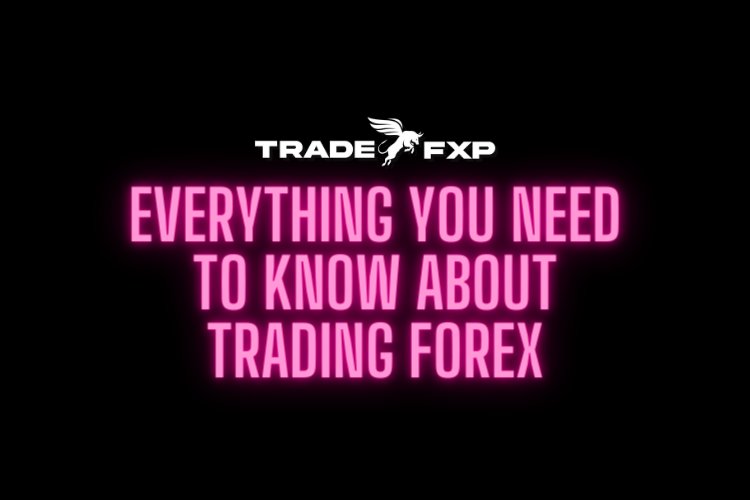Everything You Need to Know About Trading Forex
Explore the essentials of Forex trading in our comprehensive guide. From currency pairs and market analysis to trading strategies and risk management, learn everything you need to navigate the world's largest financial market. Join our Forex Managed Account Programme for simplified trading.

Everything You Need to Know About Trading Forex
Introduction
Forex, short for Foreign Exchange, affects every aspect of our daily lives, from buying our morning coffee to refueling our cars to going on holiday. In this blog, we will delve into the world of forex trading, exploring its key concepts and providing you with valuable insights to help you navigate this vast financial market.
What is Forex?
Forex, a mashup of "foreign exchange," refers to the foreign exchange market, the largest financial market in the world. Unlike the stock market, the forex market is open 24 hours a day, from 5 PM Sunday to 5 PM Friday Eastern Time. It is a decentralised market with no single central authority or exchange governing it. Instead, it is made up of a network of banks, brokers, dealers, and even governments who trade currencies with each other.
Currency Abbreviations
Each currency is represented by a three-letter code called an ISO code. Here are some of the main currencies traded in the forex market:
-
USD = US dollar
-
AUD - Australian dollar
-
NZD - New Zealand dollar
-
EUR - Euro
-
CAD - Canadian dollar
-
GBP - British pound
-
JPY - Japanese Yen
-
CHF - Swiss franc
Currency Pairs
In forex trading, currencies are traded in pairs. The first currency in a pair is the base currency, and the second currency is the quote currency. For example, in the pound-dollar currency pair, the pound is the base currency and the dollar is the quote currency. The exchange rate shows how much of the quoted currency is needed to buy one unit of the base currency.
When you buy a currency pair, you expect the base currency to appreciate while the quoted currency depreciates. Conversely, when you sell a currency pair, you expect the base currency to depreciate while the quoted currency appreciates.
Major Currency Pairs
The major currency pairs include the US dollar, as the US is the world's largest economy. It is recommended for beginners to stick to trading major currency pairs as they are the most liquid, meaning you can easily enter and exit positions with tighter bid-ask spreads.
Pips
In forex trading, exchange rate changes are measured in pips. A pip stands for "percentage in point" and represents the smallest whole unit price move that an exchange rate can make. Most currencies are written to the fourth decimal place, with the fourth decimal place representing one pip. For some currency pairs involving the Japanese yen, the pip is quoted to the second decimal place.
Lot Sizes
Positions in forex trading are usually measured in lot sizes. A standard lot represents 100,000 units of the base currency. A mini lot is a tenth the size of a standard lot, representing 10,000 units of the base currency. A micro lot is 1,000 units of the base currency, and a nano lot is 100 units of the base currency.
Bid, Ask, and Spread
Each transaction in forex trading has a bid and an ask price. The bid price is the price at which a dealer will buy a currency, and the ask price is the price at which a dealer will sell it. The difference between the bid and ask prices is called the spread. The spread covers the dealer's profit and the cost of the transaction.
Brokers and leverage
To access and trade the Forex market, individual retail traders require a broker. Brokers provide leverage, allowing traders to trade larger positions with borrowed capital. Leverage can amplify profits, but it also increases the potential for losses. Different brokers offer different leverage ratios, and traders are usually required to deposit a margin as collateral for leveraged positions.
Liquidity
The Forex market is highly liquid, meaning that many trades occur without causing significant disruptions to the exchange rate. This liquidity allows traders to quickly enter and exit trades.
Market Volatility
Market volatility refers to rapid and significant changes in prices. High volatility implies higher risk and potential reward, while low volatility indicates less risk but also less potential reward. Market volatility can be influenced by various factors, such as economic conditions, political events, and central bank decisions.
Trading Strategies
Traders employ a range of trading strategies in the Forex market. One common approach is technical analysis, where historical price movements and data are studied to identify patterns that may repeat in the future. Another method is fundamental analysis, which examines macroeconomic and geopolitical factors that influence exchange rates.
Conclusion
Trading forex offers exciting opportunities for individuals to profit from exchange rate fluctuations. Whether you prefer technical analysis or fundamental analysis, understanding the key concepts and factors that drive the Forex market is essential for successful trading. Remember to always stay informed, manage risk, and continuously improve your trading strategies.
If you don't want to go through the stress of Forex but want to make money, join our Forex Managed Account Programme (links below).
TradeFxP Features
If you choose to be a self-employed retail trader, here are a few things we offer:
-
The best trading platform
-
No Requotes
-
Lowest Spreads
-
High-level liquidity
-
Interbank connectivity
-
Pure STP/DMA/ECN
-
Free signals
-
Best support
-
Crypto Wallet and withdrawals and deposits (USDT)
-
Robust CRM
-
TradeFxP wallet
-
Once you click withdrawal
-
Multiple payment options
-
Local offices to walk into
-
Free VPS
-
Free video chat and virtual meetings
-
And many more...
If you choose to be a part of our managed account programme,
-
All of the above +
-
1-2% Daily Profits
-
High-level risk management
-
Capital protection
-
Only 30% of the capital was used.
-
Negative balance protection
-
Our fee is from the profits only.
-
Monthly profit withdrawal
-
Wallet system: use it like PhonePe or Google Pay.
-
Crypto wallet and withdrawals/deposits (USDT)
-
Live monitoring
-
MyFxbook Live Monitoring
-
Copy Trading
-
And many more...
Optional: If you do not withdraw your profits for 2 months, our system will use those profits to trade and will keep your 100% capital safe and secure for margin purposes. This is optional, and if you choose not to be a part of it, you can withdraw your profits from the first month itself.
Why 1-2% daily? Can't your managed Forex account earn more?
Yes, we can! Remember: greed may be good in the beginning, but in the end, it will destroy everything. You and I know that! Many droplets make an ocean! Join the Managed Account Programme and sit back for six months, then look at your account. You'll see that our strategy is good and the best. Do you know what I mean?
If you choose to be a part of us as an introducing broker (IB) or channel partner,
-
Industry-best rebates
-
Local office support
-
Staff support
-
Marketing support
-
Marketing materials
-
And many more...
Having said that,
You can join our Forex Managed Account program and earn 1-2% profits daily. See for yourself by clicking the below link.
Have a great journey, and may you catch some big waves on your way to prosperity!
To see Ai Forex Trading for real, use these credentials.
-
Low-risk strategy:
-
Mt4: 112018
-
PW: Allah@101
-
Server: TradeFxP live,
1. To read why you should be with us, click here.
2. To open an account, click here.
3. To see our regulation certificate, click here.
4. To see our news with the IFMRRC, click here.
5. For claims, click here.
6. For the main site, click here.
7. For blogs and articles, click here.
8. Main Website:www.TradeFxP.com



 admin
admin 










